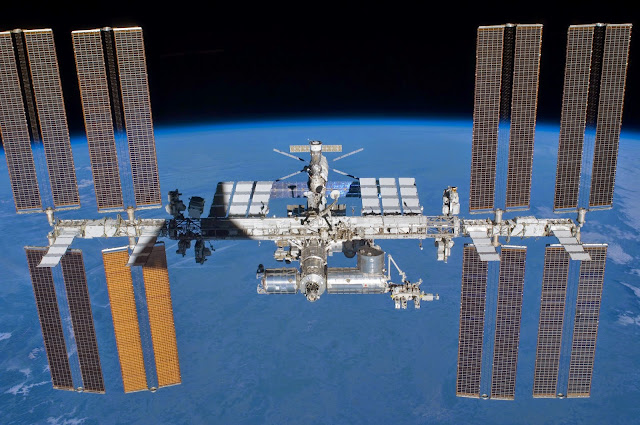ISS - International Space Station logo.
May 26, 2015
When companies try to "build a better mousetrap," the process can involve lots of internal studies and tests on the kinds of materials to use and effective designs. It can be a time-consuming but necessary operation, which means less time for people to use the device to solve a particular problem.
NASA and the National Institute of Standards and Technology (NIST) are collaborating to help scientists and innovators build that new mousetrap by accelerating materials development and make new discoveries using data from the hundreds of investigations on the International Space Station.
Image above: Dendrite formations, as shown here, affect the process of metals casting. Results from this International Space Station investigation are an example of materials science data that would be included in the MaterialsLab database. Image Credits: Peter Voorhees/Northwestern University.
An initiative between the two government agencies has created MaterialsLab – a new approach to materials science research that will provide unprecedented worldwide collaboration. Each space station investigation provides scientists with a better understanding of the physical and chemical properties of materials, allowing insight on how they develop and behave without gravity affecting the results. The MaterialsLab approach enhances the way researchers in government, industry and academia develop investigations and share information.
"We're creating a new opportunity to develop materials experiments in space that makes it easier for scientists to conduct these investigations and share their research and data widely with the scientific community," said Marshall Porterfield, NASA's director of Space Life and Physical Sciences in the agency's Human Exploration and Operations Mission Directorate at NASA Headquarters in Washington. "The Open Science concept allows multiple researchers around the world the ability to access data from station experiments and build on each other's work."
Image above: NASA astronaut Reid Wiseman conducts a session with the Binary Colloidal Alloy Test-C1 experiment during his mission on the International Space Station in 2014. Image Credits: NASA.
NASA and NIST recently signed a Memorandum of Understanding to foster collaboration among NASA’s microgravity materials science program, the NIST Material Measurement Laboratory and the multi-agency Materials Genome Initiative.
MaterialsLab will share data from past and present space station investigations through NASA’s Physical Science Informatics system -- a resource for processing and sorting data from physical science experiments performed aboard the orbiting laboratory. The goal is to promote an open access approach to scientific data analysis and potentially guide hundreds of new, station-based scientific investigations.
With MaterialsLab, NASA is changing the way scientists conduct research by adding a slight twist. Now, space station materials research will aim to solve engineering problems that not only relate to space travel, but also target a specific outcome or attack a materials problem identified by industry.
"We want to conduct new investigations that fulfill a specific industry need or could lead to a new commercial application," said John Vickers, the manager of the National Center for Advanced Manufacturing at NASA's Marshall Space Flight Center in Huntsville, Alabama. "If the automobile industry is having a problem with a specific material, we may be able to study that material on the station and get an answer that they couldn’t obtain through ground-based research. We are not only learning about the material, but also providing valuable data that immediately affects companies and consumers on Earth.”
STS-134 - International Space Station (ISS). Image Credit: NASA
Through MaterialsLab, NASA is changing the way scientists share data and even their approach to proposing experiments. "It should be easy for investigators to access current data from experiments and use it to determine if there are gaps in knowledge that can be addressed with new investigations," Porterfield said.
NASA leaders want to continue scientific experiments to learn more about the world and universe around us. They also want to change the way we conduct research by fostering a spirit of collaboration to share results from investigations on the orbiting laboratory as soon as possible.
Sharing findings from MaterialsLab in a comprehensive and open source, while building upon stored knowledge, has the potential to drive advances in materials science at a faster pace. You could see that new mousetrap on your store shelves sooner than you think.
Station Preps for Module Relocation Work
A cargo module is getting ready to be relocated from the Unity module to the Tranquility module Wednesday morning. Meanwhile, the crew also conducted science, health checks and Japanese robotics work.
Commander Terry Virts and One-Year crew member Scott Kelly prepared the Permanent Multipurpose Module (PMM) for its relocation. The duo closed the hatch on the large storage module and configured it for detachment tomorrow morning. Watch NASA TV (http://www.nasa.gov/nasatv)Wednesday morning at 8 a.m. EDT for live coverage of the PMM relocation and installation that will prepare the International Space Station for future commercial crew vehicles.
Image above: The Permanent Multipurpose Module and a docked Soyuz spacecraft were photographed by an Expedition 26 crew member while space shuttle Discovery (STS-133) was docked with the station. Image Credit: NASA.
Italian astronaut Samantha Cristoforetti worked in Japan’s Kibo lab module maneuvering its robotic arm’s Small Fine Arm to install experiment samples on an external platform. She also photographed her work during the robotics activities.
The three cosmonauts, including One-Year crew member Mikhail Kornienko, worked numerous science experiments and maintenance in the Russian segment. The trio observed how a crew member’s metabolism and motion adapt to microgravity, explored how sound waves could help pinpoint micrometeoroid impacts and studied the electromagnetic environment that surrounds space station.
Related links:
National Institute of Standards and Technology (NIST): http://www.nist.gov/
International Space Station (ISS): http://www.nasa.gov/mission_pages/station/main/index.html
Human Exploration and Operations Mission Directorate at NASA: http://www.nasa.gov/directorates/heo/home/#.VVo1cflVhBc
Materials Genome Initiative: http://materialsinnovation.tms.org/genome.aspx
NASA’s Physical Science Informatics system: http://psi.nasa.gov/
NASA's Marshall Space Flight Center: http://www.nasa.gov/centers/marshall/home/index.html
Images (mentioned), Text, Credits: NASA's Marshall Space Flight Center/Bill Hubscher/Kristine Rainey.
Cheers, Orbiter.ch





